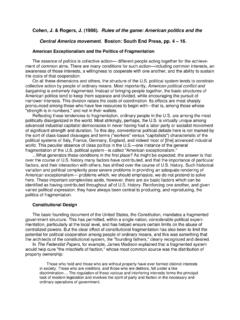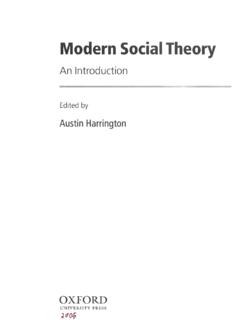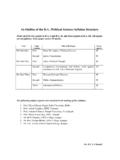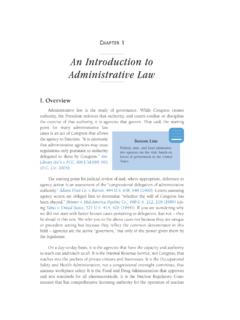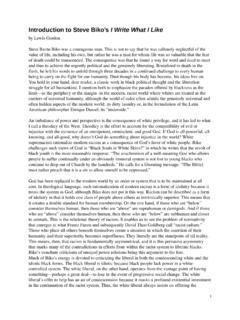Transcription of Anderson, J. E. (2003). Public policymaking: An ...
1 Anderson, J. E. (2003). Public policymaking : An introduction . Boston: Houghton Mifflin Company, pp. 1 34. Chapter 1 The Study of Public Policy In the course of their daily lives people are affected, directly and indirectly, obviously and subtly, by an extensive array of Public policies. Take, for example, automobile owners. If an automobile was purchased on time, the Truth in Lending Act required provision of accurate information by the lender on the cost of credit. The vehicle features safety equipment, such as a padded dash and seat belts, required by the National Highway Traffic Safety Administration and a catalytic converter to reduce tailpipe emissions necessitated by Environmental Protection Agency rules. Out on the highway, financed jointly by the state and national governments, our driver needs to be aware of state and local traffic regulations, or risk direct contact with law enforcement officials.
2 State policy requires that the automobile be insured and that both it and the driver be licensed. The price of the gasoline it consumes is indirectly affected by national energy policies and directly increased by national and state excise taxes. The vehicle's gas mileage must meet the national corporate average fuel economy (CAFE) standard. Public policies in a modern, complex society are indeed ubiquitous. They confer advantages and disadvantages, cause pleasure, irritation, and pain, and collectively have important consequences for our well-being and happiness. They constitute a significant portion of our environment. This being so, we should know something about Public policies, including how they are formed, budgeted, implemented, and evaluated. There are also scientific, professional, and political reasons for studying Public policies and policymaking . Scientifically the systematic and rigorous study of the origins, development, and implementation of Public policies will enhance our knowledge of political behavior and governance, as well as of Public policy per se.
3 How is policymaking affected by federalism and the separation of powers? Were pressure groups or Public opinion or the media influential in the adoption of a policy? Why did government cease to be concerned with a problem? Concern with questions of this sort are designated as policy study. Professionally, a person may pursue a career as a policy analyst or evaluator. Practitioners of policy analysis, which draws heavily upon economic theory and statistical and mathematical analytical techniques, have been growing in number in recent Policy analysis has an applied orientation and seeks to identify the most efficient alternative ( , the one that will yield the largest net social benefit) for dealing with a current problem, such as the control of air pollution or the disposal of household garbage. A variant of policy analysis is evaluation research, which assesses how well policies attain their goals and the other societal effects that they may have.
4 Politically, many people want to engage in policy advocacy, using knowledge of Public policy to formulate and promote "good" Public policies that will have the "right" goals, that is, goals which serve their purposes. They may think of themselves as liberals, conservatives, libertarians, communitarians, or socialists and disagree greatly in their notions of what is good or just. The research efforts of policy advocates are frequently skewed by their wish to generate data and analysis in line with their preferences. In contrast, policy study is motivated by the intent to be impartial. This book draws on the scientific policy studies approach to develop a basic understanding of the policymaking process, which is here viewed as an inherently political process involving conflict and struggle among people ( Public officials and private citizens) with conflicting interests, values, and desires on policy issues.
5 In describing and analyzing the policymaking process, the scientific policy studies approach has three basic First, its primary goal is to explain the adoption of a policy rather than to identify or prescribe "good" or proper policy. Analysis, rather than advocacy, is its style. Second, it rigorously searches for the causes and consequences of Public policies by applying social-scientific methodology, which is not restricted to the use of quantitative data and methodology. At a minimum, it does require that one should strive to be rational, empirical, and objective. Third, this approach aims to develop reliable theories and explanations about Public policies and their politics. Thus policy studies can be both theoretical and somewhat relevant to the more practical aspects of policy-making. It has been said that nothing is as practical as a good theory. What Is Public Policy? In general usage, the term policy designates the behavior of some actor or set of actors, such as an official, a governmental agency, or a legislature, in an area of activity such as Public transportation or consumer protection.
6 Public policy also may be viewed as whatever governments choose to do or not to do. Such definitions may be adequate for ordinary discourse, but because we set out in this book to do a systematic analysis of Public policy, a more precise definition or concept is needed to structure our thinking and to facilitate effective communication with one another. In this book a policy is defined as a relatively stable, purposive course of action followed by an actor or set of actors in dealing with a problem or matter of concern. This definition focuses on what is actually done instead of what is only proposed or intended; differentiates a policy from a decision, which is essentially a specific choice among alternatives; and views policy as something that unfolds over time. Public policies are those developed by governmental bodies and officials. (Nongovernmental actors and factors may of course influence Public -policy development.)
7 The special characteristics of Public policies stem from their being formulated by what political scientist David Easton has called the "authorities" in a political system, namely, "elders, paramount chiefs, executives, legislators, judges, administrators, councilors, monarchs, and the like." These are, he says, the persons who "engage in the daily affairs of a political system," are "recognized by most members of the system as having responsibility for these matters," and take actions that are "accepted as binding most of the time by most of the members so long as they act within the limits of their roles."3 In short, Public policies are those produced by government officials and agencies. They also usually affect substantial numbers of people. There are several implications of this concept of Public policy as a relatively stable, purposive course of action followed by government in dealing with some problem or matter of concern.
8 First, the definition links policy to purposive or goal-oriented action rather than to random behavior or chance occurrences. Public policies in modern political systems do not, by and large, just happen. They are instead designed to accomplish specified goals or produce definite results, although these are not always achieved. Proposed policies may be usefully thought of as hypotheses suggesting that specific actions be taken to achieve particular goals. Thus, to increase farm income, the national government utilizes income subsidies and production controls. These programs have indeed enhanced the incomes of many farmers, but by no means all. The goals of a policy may be somewhat loosely stated and cloudy in content, thus providing general direction rather than precise targets for its implementation. Those who want action on a problem may differ both as to what should be done and how it should be done.
9 Ambiguity in language then can become a means for reducing conflict, at least for the moment. Compromise to secure agreement and build support may consequently yield general phrasing and lack of clarity in the statement of policy goals. Second, policies consist of courses or patterns of action taken over time by governmental officials rather than their separate, discrete decisions. It is difficult to think of such actions as a presidential decision to honor a movie actor or a Social Security Administration decision to award disability benefits to Joe Doaks as Public policies. A policy includes not only the decision to adopt a law or make a rule on some topic but also the subsequent decisions that are intended to enforce or implement the law or rule. Industrial health and safety policy, for example, is shaped not only by the Occupational Safety and Health Act of 1970 but also by a stream of administrative rules and judicial decisions interpreting, elaborating, and applying (or not applying) the act to particular situations.
10 Third, Public policies emerge in response to policy demands, or those claims for action or inaction on some Public issue made by other actors private citizens, group representatives, or legislators and other Public officials upon government officials and agencies. Such demands may range from general insistence that a municipal government "do something" about traffic congestion to a specific call for the national government to prohibit theft of pet dogs and cats for sale to medical and scientific research organizations. In short, some demands simply call for action; others also specify the action desired. In response to policy demands, Public officials make decisions that give content and direction to Public policy. These decisions may enact statutes, issue executive orders or edicts, promulgate administrative rules, or make judicial interpretations of laws. Thus the decision by Congress to enact the Sherman Antitrust Act in 1890 was a policy decision; another was the 1911 Supreme Court ruling that the act prohibited only unreasonable restraints of trade rather than all restraints of trade.

